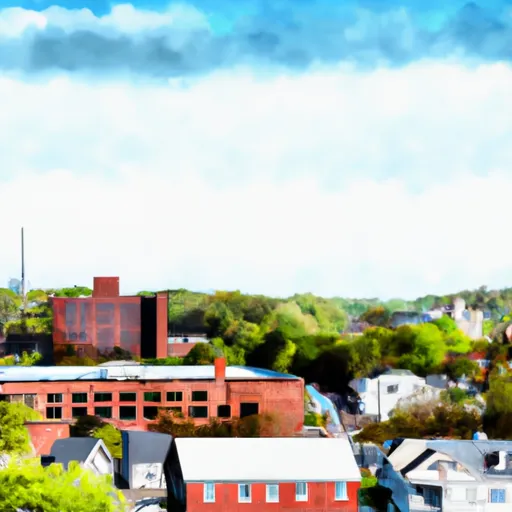-
 Snoflo Premium
Snoflo Premium
Get unlimited access to all our content
With no Ad interruptions! - Start Your Free Trial Login with existing account
Woburn
Eden Index
Climate
9.1
•
Recreation
5.0
•
Community
6.6
•
Safeguard
7.1/10

Woburn, Massachusetts, is a vibrant city located about 10 miles north of Boston. It experiences a humid continental climate, characterized by four distinct seasons. Winters are cold, with average temperatures ranging from the low 20s to the mid-30s Fahrenheit, while summers are warm and humid, with temperatures ranging from the mid-60s to the mid-80s Fahrenheit. Spring and fall seasons offer pleasant weather with temperatures in the 50s and 60s Fahrenheit.
The city boasts several bodies of water, including the Horn Pond and the Shawsheen River, which contribute to its hydrology constituents. These water resources not only enhance the natural beauty of the area but also provide opportunities for various outdoor activities. Residents and visitors can enjoy boating, fishing, and picnicking at Horn Pond, while the Shawsheen River offers opportunities for kayaking, canoeing, and exploring its scenic banks.
In addition to its water-based activities, Woburn provides numerous outdoor recreation opportunities in its parks and green spaces. Residents can enjoy hiking and biking trails, playgrounds, sports fields, and picnic areas in parks like Horn Pond Conservation Area, Horn Pond Mountain, and Forest Park.
Overall, Woburn, Massachusetts, offers a diverse climate, abundant water resources, and numerous outdoor recreation opportunities, making it an attractive place for nature enthusiasts and outdoor lovers.
What is the Eden Index?
The Snoflo Eden Index serves as a comprehensive rating system for regions, evaluating their desirability through a holistic assessment of climate health, outdoor recreation opportunities, and natural disaster risk, acknowledging the profound impact of these factors on livability and well-being.
Climate Health Indicator (CHI): 9.1
Woburn receives approximately
1277mm of rain per year,
with humidity levels near 72%
and air temperatures averaging around
10°C.
Woburn has a plant hardyness factor of
6, meaning
plants and agriculture in this region thrive during a short period during spring and early summer. Most
plants will die off during the colder winter months.
By considering the ideal temperature range, reliable water supplies, clean air, and stable seasonal rain or snowpacks, the Climate Health Indicator (CHI) underscores the significance of a healthy climate as the foundation for quality living.
A healthy climate is paramount for ensuring a high quality of life and livability in a region, fostering both physical well-being and environmental harmony. This can be characterized by ideal temperatures, reliable access to water supplies, clean air, and consistent seasonal rain or snowpacks.
Weather Forecast
Streamflow Conditions
Massachusetts-Rhode Island Coastal
Area Rivers
Massachusetts-Rhode Island Coastal
Snowpack Depths
Massachusetts-Rhode Island Coastal
Reservoir Storage Capacity
Massachusetts-Rhode Island Coastal
Groundwater Levels
Recreational Opportunity Index (ROI): 5.0
The Recreational Opportunity Index (ROI) recognizes the value of outdoor recreational options, such as parks, hiking trails, camping sites, and fishing spots, while acknowledging that climate plays a pivotal role in ensuring the comfort and consistency of these experiences.
Access to outdoor recreational opportunities, encompassing activities such as parks, hiking, camping, and fishing, is crucial for overall well-being, and the climate plays a pivotal role in enabling and enhancing these experiences, ensuring that individuals can engage in nature-based activities comfortably and consistently.
Nearby Ski Areas
Catastrophe Safeguard Index (CSI):
The Catastrophe Safeguard Index (CSI) recognizes that natural disaster risk, encompassing floods, fires, hurricanes, and tornadoes, can drastically affect safety and the overall appeal of an area.
The level of natural disaster risk in a region significantly affects safety and the overall livability, with climate change amplifying these risks by potentially increasing the frequency and intensity of events like floods, fires, hurricanes, and tornadoes, thereby posing substantial challenges to community resilience and well-being.
Community Resilience Indicator (CRI): 6.6
The Community Resilience Indicator (CRI) recognizes that education, healthcare, and socioeconomics are crucial to the well-being of a region. The CRI acknowledges the profound impact of these elements on residents' overall quality of life. By evaluating educational resources, healthcare accessibility, and economic inclusivity, the index captures the essential aspects that contribute to a thriving community, fostering resident satisfaction, equity, and social cohesion.

